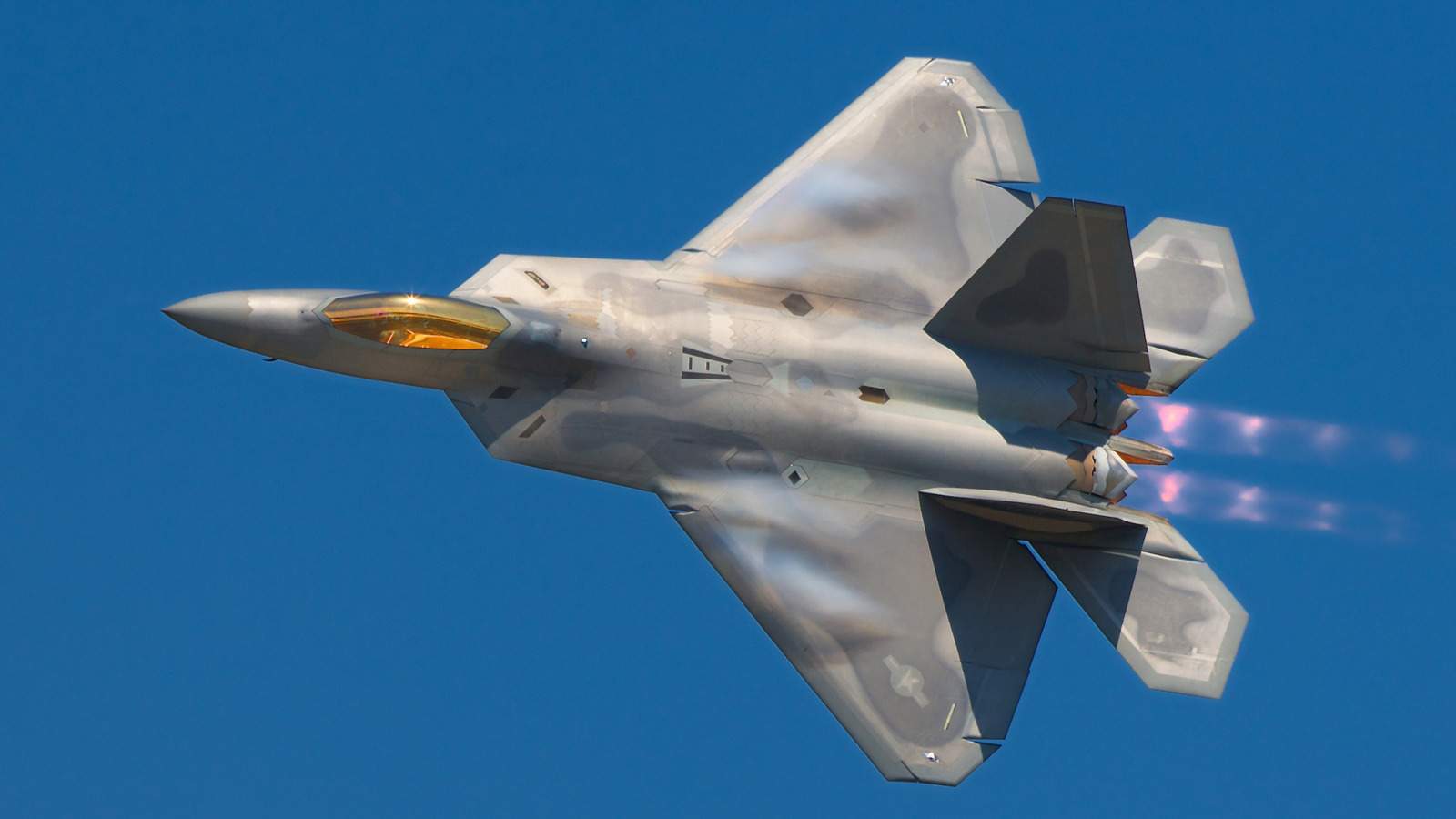
Pratt & Whitney has powered some of the world’s most famous aircraft since biplanes ruled the sky 100 years ago, beginning with the company’s founding in 1925. Pratt & Whitney’s Wasp engine changed air travel forever with its air-cooled radial design. During World War II, the company built more than 360,000 power plants for Allied aircraft. As the war drew near its end and the Cold War loomed, it was time for the company to enter the Jet Age.
Advertisement
Pratt & Whitney’s jet engine development began in 1944. Its first model was licensed from Rolls-Royce and was called the Nene, although it later became known as the J42 Turbo-Wasp. Further development with Rolls-Royce led to a new after-burner-equipped model called the J48 Turbo-Wasp that was almost one-third more powerful. In fact, with 7,250 pounds of thrust, it was the most powerful jet engine in America or the United Kingdom. It would go on to power several models of combat aircraft.
Pratt & Whitney would develop jet engines for a wide range of commercial, general, and military aviation roles. For instance, it makes engines for the C-17 Globemaster cargo aircraft and the Boeing KC-46 Pegasus tanker. The legendary SR-71 used the J58 turbojet engine from Pratt & Whitney to reach Mach 3 on its reconnaissance flights over the Soviet Union. But some of the most demanding applications for jet power remain fighter jets, and Pratt & Whitney has provided engines for several of the most advanced fighters in each era. We’ll look at eight of the most important Pratt & Whitney-powered dogfighters, multi-role fighters, and interceptors of the Jet Age.
Advertisement
Grumman F9F Panther/Cougar (1947/1951)
The Grumman F9F Panther was one of America’s first carrier-based jet fighters, and the U.S. Navy specified that it should be designed to accept either a Pratt & Whitney engine or one from its rival, the Allison Engine Company. The Navy planned to use whichever engine proved to be the most capable. Pratt & Whitney’s entrant was the Nene, the powerplant licensed from Rolls-Royce. Allison’s engine was the J-33-A-8. The Nene outclassed the J-33 in total thrust by 5,700 pounds to 4,600 pounds, and by the time the Panther went into production as the F9F-3, Pratt & Whitney’s engine had won.
Advertisement
Since the Nene engine, now known as the J-42-P-6, had powered the XF9F-2 prototype, the F9F-3 models were retroactively made into F9F-2s. The Grumman F9F Panther was unique among carrier aircraft at the time, with a top speed of 600 mph at sea level. When the F9F-4 generation debuted, it originally carried Allison J-33 engines. However, the Navy soon replaced them with the Pratt & Whitney J-48-P-2. The F9F-5 variants would get the J-48-P-6.
Despite the dash-5 fighters being heavier, the more powerful J-48 engine kept them fast and deadly. Maximum speed was 604 mph at sea level with a climb rate of 6,000 feet per minute. Cruising speed was 481 mph, and range was 1,300 miles. Along with its four 20 mm cannons, the J-48 gave the Panther enough power to carry six rockets or 2,000 pounds of bombs. When the Panther evolved into the swept-wing F9F-6 Cougar in 1951, Pratt & Whitney’s J-48 engines continued to be the Navy’s choice, now updated to 7,250 pounds of thrust. Top speed was Mach 0.895, up from the Panther’s 0.787.
Advertisement
Lockheed F-94C Starfire (1950)
In 1948, the U.S. Air Force grew concerned about the threat posed by the Soviet Union’s new long-range bombers. It issued a request for an interceptor that could use radar to find and kill enemy bombers. Lockheed answered the call with the F-94 Starfire, which first flew in 1949. The F-94 was developed from the T-33A Shooting Star trainer jet, which was itself a derivative of the F-80 Shooting Star, the Air Force’s first operational jet, whose development began during World War II. Therefore, the Starfire had DNA going back to the very beginning of the Jet Age.
Advertisement
The F-94 series included A, B, and C variants. The F-94C model first flew in 1950. It was such a marked improvement over previous planes in the Starfire series that it was practically an all-new plane. Fundamental to that transformation was an increase in power, courtesy of a single Pratt & Whitney J48-P-5 or J48-P-5A with an afterburner. With 8,750 pounds of thrust, it propelled the F-94C to a maximum speed of 640 mph with a cruising speed of 476 mph. Its range was 1,275 miles, and its ceiling was almost 52,000 feet. The new jet had the speed and range for its mission as an all-weather interceptor.
This jet used three pods of Folding Fin Air Rockets, one in the nose and two on the wings, rather than guns to attack enemy aircraft. Of the 855 F-94s built, only one was lost in combat. The F-94C scored several air-to-air victories in the Korean War. The last one was retired in 1960, a relatively short lifespan due to the fast-evolving technology of jet fighters in that era.
Advertisement
North American Aviation F-100 Super Sabre (1953)
The F-100 Super Sabre made history as the first supersonic fighter jet in the world. Other aircraft had achieved supersonic speeds, but not in level flight, needing an extra assist from gravity to break the sound barrier. The Super Sabre achieved this feat in level flight by the sheer power of a single Pratt & Whitney J57-P-21 turbojet engine with an afterburner. The Super Sabre was developed from the earlier F-86 Sabre from North American Aviation, an aircraft which had achieved an impressive record in the skies above Korea. However, the U.S. Air Force saw the need for a faster jet to keep up with advances made by the Soviets, who were debuting high-speed swept-wing fighters like the MiG-15.
Advertisement
North American proposed a derivative of the F-86 with a 45-degree wing sweep. The Pentagon ordered more than 100 of them in 1952, and by 1954, the F-100 was in service. The jet proved to be a success, and eventually more than 2,000 would be built for air forces around the world. In addition to its speed, it proved to be an excellent dogfighter as well as a good interceptor.
The role of the Super Sabre would expand even more when it was developed into the F-100D, a fighter-bomber variant. The D version featured a supersonic autopilot, an enlarged fin and rudder, and beefed-up weapons pylons. This configuration enabled it to carry over 7,000 pounds of ordnance. With an upgraded Pratt & Whitney J57-P-21A engine with 16,000 pounds of thrust in afterburner, its top speed was 892 mph. The Super Sabre in all its variants was a very successful warplane that served for decades.
Advertisement
McDonnell-Douglas F-15 Eagle (1972)
Tracing the F-15 Eagle’s history from its first flight in 1972 through the upcoming F-15EX Eagle II is to follow the development of jet fighter technology and tactics over the past 5 decades. The Nixon-era prototype was called the F-15A, while the F-15B was delivered in 1974. Upgraded F-15C single-seat and F-15D two-seat versions followed in 1979 with greater fuel capacity and increased takeoff weight. In the 1980s, further upgrades enabled the plane to carry advanced missiles, along with improved radar and countermeasures.
Advertisement
Through this period of development, each Eagle was powered by a pair of Pratt & Whitney F100-PW-100, -220, or -229 engines. These turbofans with afterburners produced up to 23,450 pounds of thrust each, enabling speeds of up to 1,875 mph, making the Eagle a Mach 2-class aircraft. Range was up to 3,450 miles with external fuel tanks. The Eagle sported a six-barrel 20 mm cannon and hard points for as many as eight externally mounted missiles. The engines’ tremendous power made the F-15 the first U.S. jet whose thrust was greater than its fully loaded weight.
Yet its evolution wasn’t complete. The F-15E Strike Eagle debuted in 1988 as a dual-role fighter that was the first Eagle variant designed to perform air-to-ground missions in addition to air-to-air combat. Sophisticated radar can lock onto the positions of ground targets, while the LANTIRN targeting system can hit those targets even at night or in poor weather. The weapons officer in the rear seat has four screens to monitor targeting data and potential threats. The Strike Eagle does all this while powered by Pratt & Whitney F100-PW-220 or 229 engines.
Advertisement
Lockheed Martin F-16 Fighting Falcon (1976)
By the 1970s, jet fighters had grown in size, weight, and complexity. The U.S. Air Force’s ability to deliver weaponry was unmatched, but its planes weren’t especially maneuverable. The F-16 Fighting Falcon was designed to counter this trend by being small, lightweight, agile, and relatively cheap. It would be able to outmaneuver enemy fighters and missiles. Its blended-wing body would help it achieve this task, while also providing extra lift. Critically, as a lightweight single-engine fighter, its engine would have to be small but very powerful.
Advertisement
The F-16 follows an unusual practice of alternating engine suppliers between different production blocks. GE delivers the engines for some blocks, while Pratt & Whitney supplies others. In the YF-16 prototype, a Pratt & Whitney engine produced 23,000 pounds of thrust. The amount of thrust has grown over the decades along with the F-16’s capabilities and weight. Today, the Pratt & Whitney F100-PW-229 generates 29,160 pounds of thrust out of an engine that weighs only 3,826 pounds, making it one of the biggest strengths of F-16 fighter jets.
Despite its light weight, the F-16’s power enables it to carry a full complement of weaponry. Along with a 500-round, 20 mm cannon, it offers external hard points for mounting up to six missiles for air-to-air and air-to-ground missions. It can also carry a pair of 2,000-pound bombs. It’s also fully equipped with advanced avionics and countermeasures. Top speed is very impressive for a single-engine fighter at 1,500 mph or Mach 2. Maximum range is 2,000 miles with external tanks. F-16s are produced by a consortium that includes the U.S., Belgium, Denmark, Norway, the Netherlands, and Portugal, making it one of the backbones of NATO’s air defense.
Advertisement
IAI Lavi (1986)
The Israeli Air Force has traditionally been one of the country’s biggest military strengths, but it has long relied on imported fighter jets to accomplish its mission. This is an obvious liability for any air force, and it became a critical issue when France embargoed Israel in the 1960s, cutting off an order of new Mirage jets. The Israelis responded by initiating their own fighter jet development program. Israel launched the program with an unlicensed Mirage knockoff called the Kfir, which demonstrated its ability to build aircraft. Next up was an entirely indigenously designed, clean-sheet-of-paper fighter called the Lavi, meaning “Young Lion.”
Advertisement
Although the Lavi was originally intended to be a fairly simple jet, it evolved into a sophisticated delta-wing fighter with steerable canards, carbon fiber structure, and advanced digital avionics. Flight tests began in 1986, and the program received advanced technology from American defense contractors. Among these technologies was the Pratt & Whitney PW1120 turbofan engine. This engine had been developed specifically for this project and generated 20,600 pounds of thrust. Lavi prototypes achieved Mach 1.85.
However, the project faced opposition both within the U.S. and even from the Israeli Air Force leadership, who felt the money could be better spent importing the F-16C. The Lavi was ultimately canceled in 1987. Though abandoned after building just three prototypes, the project significantly boosted Israel’s aerospace industry capabilities. Some Lavi-developed components became successful exports, such as the Elta EL/M-2032 pulse-doppler radar. The Israeli aerospace industry has also proven its prowess by modifying American aircraft to its own needs, such as the F-15I Raa’am and the F-35I Adir.
Advertisement
Lockheed Martin F-22 Raptor (1997)
When the F-22 Raptor entered service, it was a generation ahead of any other aircraft in the skies. The jet is so advanced that the United States banned the export of the Raptor even to its closest allies. The F-22 Raptor’s construction materials include a mix of lightweight metals like titanium and aluminum, along with advanced composites, thermoplastics, and radar-absorbing materials. Its avionics include the Joint Tactical Information Distribution System (JTIDS) for complete battlespace awareness. And, of course, it is very, very fast, capable of flying at Mach 2. Perhaps even more impressive is the fact that it can cruise at Mach 1.5 without even using its afterburners.
Advertisement
Part of this speed is attributable to its advanced design, and part of it comes from its engines: a pair of Pratt & Whitney F119-PW-100 turbofan engines. At 35,000 pounds of thrust each, they give the F-22 more total thrust than any other current jet fighter on earth. Plus, they offer thrust vectoring to give the Raptor maneuverability that approaches the edge of what’s possible. Thrust vectoring comes from nozzles on the engine outlets, which move in tandem with the flight control surfaces or can be directed manually by the pilot.
Thrust vectoring is an integral part of the F-22’s role as an air superiority fighter. It’s especially useful at lower speeds where regular control surfaces don’t work as well, and it gives the Raptor an edge in air-to-air combat. An experimental aircraft called the X-31 was used as a demonstrator for thrust vectoring in the 1990s and achieved a 91 percent win ratio in combat simulations, demonstrating the technology’s value. The F-22 can also perform air-to-ground attacks, as it did in its first live combat in Syria in 2014.
Advertisement
Lockheed Martin F-35 Lightning II (2006)
The F-35 Lightning II gives the armed services of the United States and key allies a plane with the stealth and situational awareness to handle everything from air-to-air combat to close air support. With its next-generation stealth and avionics, it’s arguably the most advanced fighter jet in the world. Every F-35 pilot has complete awareness of the battlespace, in the air and on the ground. While it’s considered a Lockheed aircraft, Northrop Grumman builds the center fuselage and some of the radar and communications systems. And, of course, Pratt & Whitney provides the engines.
Advertisement
They are called F135 engines, and they are among the most advanced aircraft powerplants on earth. They lie at the heart of all three variants of the F-35: the U.S. Air Force’s F-35A, the U.S. Marine Corps’ F-35B short takeoff and landing jet, and the U.S. Navy and Marine Corps’ F-35C carrier version. Each jet sports one of these F135 turbofan units, which generate a stunning 43,000 pounds of thrust in the F-35A, whose top speed is Mach 1.6, or about 1,200 mph. Its flight ceiling exceeds 50,000 feet, and the range is 1,350 miles. In the Marines’ F-35B, to assist with short takeoffs and vertical landings, the engine powers the shaft-driven LiftFan.
Potential adversaries are always advancing, and the F-35 needs to stay at the forefront. To that end, the F135 Engine Core Upgrade (ECU) enhances the F-35’s engine architecture to support Block 4 capabilities and future updates. The ECU also provides increased power and thermal management capacity. To accomplish this, Pratt & Whitney used lessons learned from the U.S. Navy’s Fuel Burn Reduction initiative and other programs.
Advertisement








